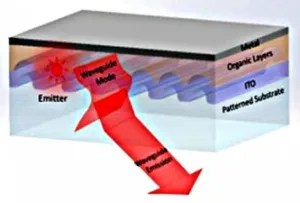A team of researchers headed by Xiangyu Fu in the Department of Materials Science and Engineering at North Carolina State University (Raleigh, NC) are developing a means to control the direction and polarization of light emitted from thin film LEDs. One reason that this development is significant is that it has the potential to improve display performance in such ways as to enable VR and AR headsets that are substantially lighter, less bulky and that have improved energy efficiency.

Part of the reason that shaping and directing the light emitted by thin film LEDs has proven difficult is due to the fact that the distribution of the light naturally emitted by a thin film LED is Lambertian. Several means have been developed to shape the light output by thin film LEDs including:
- Using a distributed Bragg reflector to enhance the cavity resonance.
- Using a “point” thin film LED source and a microlens to focus the light.
- Vertically stacking a diffractive optical element and the waveguide with the thin film LED for more efficient waveguide coupling and extraction.
- Coupling light from a thin film LED line source to a thin film waveguide and using a diffractive optical element to extract the waveguide mode.
Some of the means that have been developed to produce polarized light output include:
- Mechanically align the emitting molecules.
- Use of a fine metallic grating as an external polarizer.
As might be expected, all of these means to shape and polarize the light emitted by thin film LEDs have advantages and disadvantages. The recent work undertaken by the researchers was intended to find a means in which the balance of advantages and disadvantages add up to a better solution. As discussed below, a significant feature of the approach adopted by the researchers to achieve directional and polarized light emission in thin film LEDs is that it was accomplished without the need for an external optical element.
A recent article by the team on this topic is entitled “Directional Polarized Light Emission from Thin?Film Light?Emitting Diodes.” It was published on January 29th in Advanced Materials. A copy of the article is on-line and available for purchase. It can be found here.
In their work, the approach adopted by the researchers’ used thin film organic and perovskite-based LED devices. In the prototype devices, the researchers were able to selectively diffract the transverse electric waveguide mode while suppressing other optical modes. This was accomplished by the use of nanostructures. The nanostructures included a corrugation at the top cathode that was planarized by thermal evaporation of a thick organic stack and by solution processing. The configuration of the prototype device is illustrated in the figure below.
Configuration of the prototype thin film LED device that emits directionally polarized light.
The result of measurements made on the prototypes and reported in their article describe the demonstration of highly directional light emission from a full area OLED. The emitted light had a small divergence angle, less than 3 degrees. In addition, the transverse electric to transverse magnetic polarization extinction ratio was quite high at 13.
In addition, the researchers point out that perovskite emitters are perfect candidates for waveguide emission due to their intrinsically high refractive index. By extracting the transverse electric waveguide modes into the forward direction, waveguide emission in a perovskite LED prototype was demonstrated that had an enhancement of 2.6 times the current efficiency as compared to a reference planar device. This represents a major enhancement in efficiency in perovskite LEDs.
The researchers conclude their article with the statement that with this new approach, thin film LEDs that exhibit strong directional and polarized light emission are simple to fabricate and that the fabrication process should be easy to scale up. -Arthur Berman
North Carolina State University, Franky So, [email protected]

